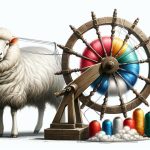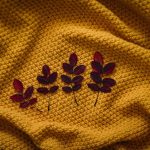Are you curious about how fabric is made, from start to finish? In this article, we will guide you through the journey of fabric production with 12 helpful tips.
You will discover the process of sourcing raw materials, preparing fibers, spinning yarn, and dyeing techniques.
We will also explore weaving or knitting the fabric, quality control, sustainable practices, and emerging trends.
Get ready to trace the incredible progress of fabric production!
Table of Contents
Sourcing Raw Materials
To source raw materials for fabric production, you can start by researching suppliers and evaluating their sourcing practices. Look for suppliers who prioritize ethical production and sustainable sourcing practices. This includes suppliers who prioritize the use of organic and renewable materials, as well as those who support fair trade practices. These suppliers will ensure that the raw materials used in fabric production are obtained in an environmentally responsible and socially conscious manner.
Additionally, consider suppliers who have certifications such as the Global Organic Textile Standard (GOTS) or Oeko-Tex Standard 100. These certifications guarantee that the raw materials used in fabric production meet strict environmental and ethical standards.
It’s also important to consider the location of the supplier. Choosing suppliers who are closer to your production facilities can help reduce the carbon footprint associated with transportation.
Preparing the Fibers
Start by examining the process of preparing the fibers for fabric production. Fiber preparation techniques play a crucial role in ensuring the quality and durability of the final fabric. One common technique is carding, where fibers are passed through metal teeth to remove impurities and align them in the same direction. This process creates a long, continuous strand of fiber known as a sliver. Another technique is combing, which further refines the fiber by removing shorter fibers and creating a smoother and more uniform sliver.
Once the fibers have been prepared, they can be blended together using various fiber blending methods. Blending allows manufacturers to create fabrics with specific properties by combining different types of fibers. One method is mechanical blending, where fibers are mechanically mixed together using machines like carding engines or blending hoppers. Another method is air blending, which uses compressed air to mix fibers in a controlled manner. This technique is particularly useful for blending different colors or creating unique patterns in the fabric.
Spinning the Yarn
Now, let’s delve into the next stage of fabric production: spinning the yarn.
After the fiber preparation process, the next step is to transform the prepared fibers into yarn. Yarn production is a crucial stage in the fabric production process, as it determines the strength, texture, and overall quality of the final fabric.
During yarn production, the prepared fibers are twisted together to form a continuous strand. This twisting action helps to bind the fibers together, creating a strong and durable yarn. The type of twist used can vary depending on the desired characteristics of the final fabric. For example, a tighter twist will result in a stronger yarn, while a looser twist will create a softer and more flexible yarn.
There are different methods of yarn production, including hand spinning and machine spinning. Hand spinning involves using a spinning wheel or drop spindle to twist the fibers together manually. This method allows for more control over the yarn’s characteristics but is time-consuming and labor-intensive.
On the other hand, machine spinning uses automated processes to produce yarn quickly and efficiently.
Dyeing and Coloring Techniques
Once you have spun the yarn, it’s time to explore the various dyeing and coloring techniques used in fabric production. Dyeing is the process of imparting color to the yarn or fabric, and there are two main types of dyeing techniques: natural dyeing techniques and synthetic colorants.
Natural dyeing techniques involve using dyes derived from plants, animals, or minerals. These dyes have been used for centuries and offer a range of colors that are vibrant and earthy. Examples of natural dyes include indigo, derived from the indigo plant, and cochineal, derived from insects.
On the other hand, synthetic colorants are created in a laboratory and offer a wide range of colors that may not be found in nature. These dyes are often more vibrant and long-lasting than natural dyes. Synthetic colorants are commonly used in modern fabric production due to their versatility and availability.
To give you a clearer understanding, here is a table that compares natural dyeing techniques and synthetic colorants:
| Natural Dyeing Techniques | Synthetic Colorants |
|---|---|
| Derived from plants, animals, or minerals | Created in a laboratory |
| Offer a range of vibrant and earthy colors | Offer a wide range of colors |
| May fade over time | More resistant to fading |
Weaving or Knitting the Fabric
To weave or knit the fabric, you’ll need to choose the appropriate technique based on the type of yarn and desired outcome. Here are four important things to consider when it comes to weaving techniques and knitting patterns:
-
Weaving Techniques:
- Plain Weave: The simplest and most common weaving technique, where the weft yarn passes over and under each warp yarn.
- Twill Weave: Creates a diagonal pattern and is often used for denim and other sturdy fabrics.
- Satin Weave: Produces a smooth and lustrous fabric with long floats, commonly used for luxurious materials like silk and satin.
- Jacquard Weave: Allows for intricate and complex patterns, often seen in upholstery and tapestries.
-
Knitting Patterns:
- Stockinette Stitch: Creates a smooth fabric with a ‘V’ pattern on one side and a purl pattern on the other.
- Garter Stitch: Produces a bumpy texture on both sides, achieved by knitting every row.
- Rib Stitch: Creates vertical columns of knit and purl stitches, often used for cuffs and hems.
- Cable Stitch: Adds texture and creates a twisted rope-like pattern by crossing stitches over each other.
Finishing and Treatments
After weaving or knitting the fabric, the next step in the fabric production process involves finishing and treatments. Finishing processes are essential to enhance the fabric’s appearance, durability, and functionality. There are various treatment techniques used to achieve these desired outcomes.
One common finishing process is called bleaching, which involves removing any natural color from the fabric to create a white base. This is often done using chemical agents, such as hydrogen peroxide or sodium hypochlorite.
Another important finishing process is dyeing, where color is added to the fabric to create various shades and patterns. Dyeing can be done using different methods like vat dyeing, reactive dyeing, or pigment dyeing.
Additionally, treatments like waterproofing and flame retardant finishes are applied to fabrics to make them resistant to water or fire, respectively. These treatments involve applying special coatings or chemicals to the fabric surface.
Another treatment technique is called mercerization, which improves the fabric’s strength, luster, and dye affinity by treating it with caustic soda.
Printing and Embellishing
Now let’s talk about the fascinating world of fabric printing and embellishing.
You’ll learn about the various dyeing techniques used to create vibrant and intricate designs on fabric.
Additionally, we’ll explore the impact of embellishments on the overall look and feel of a fabric, as well as the latest trends in fabric printing.
Get ready to discover the artistry and innovation behind these captivating techniques.
Dyeing Techniques Used
Explore the various dyeing techniques, such as printing and embellishing, used in fabric production to enhance its visual appeal and aesthetic quality. Dyeing plays a crucial role in transforming plain fabrics into vibrant works of art.
Here are four dyeing techniques you should know about:
-
Traditional Techniques: These time-honored methods have been used for centuries and involve natural dyes made from plants, insects, and minerals. They not only create unique and rich colors but also have minimal impact on the environment.
-
Eco-Friendly Options: With sustainability becoming increasingly important, eco-friendly dyeing techniques have gained popularity. These methods use natural and non-toxic dyes, as well as innovative technologies that minimize water and energy consumption.
-
Printing: This technique involves applying color to the fabric’s surface using various methods, such as screen printing, block printing, or digital printing. It allows for intricate designs and patterns, adding depth and dimension to the fabric.
-
Embellishing: Embellishment techniques, like embroidery, beading, or sequin work, add texture and decorative elements to the fabric. These techniques give fabrics a luxurious and ornate look, making them perfect for special occasions or high-end fashion.
Impact of Embellishments
Enhance the visual appeal and aesthetic quality of fabric production by incorporating embellishments through printing and embellishing techniques. These techniques not only add unique patterns and designs to the fabric but also have a significant impact on sustainable fabric production.
By using embellishments, fabric manufacturers can create visually stunning fabrics that are in line with current fashion trends. This allows them to cater to the demands of consumers and stay competitive in the market. Moreover, printing and embellishing techniques can also be used to revive old or unused fabric, reducing waste in the production process.
To better understand the impact of embellishments, consider the following table:
| Impact of Embellishments | Sustainable Fabric Production |
|---|---|
| Adds value to the fabric | Reduces waste |
| Attracts more customers | Increases fabric lifespan |
| Enhances product appeal | Promotes reuse and recycling |
| Provides design options | Supports eco-friendly fashion |
Embellishments play a crucial role in making fabric production more sustainable by adding value, reducing waste, and attracting more customers. By incorporating printing and embellishing techniques, fabric manufacturers can create high-quality products that are both visually appealing and environmentally friendly.
Trends in Fabric Printing
To stay up-to-date with the latest trends in fabric production, incorporate the use of innovative printing and embellishing techniques.
The world of fabric printing has seen significant advancements in recent years, with digital printing taking center stage. This method allows for intricate designs, vibrant colors, and precise detailing, all while reducing waste and minimizing environmental impact.
Additionally, eco-friendly methods are becoming increasingly popular in fabric printing, as consumers are becoming more conscious of sustainability. From using water-based inks to utilizing recycled materials, eco-friendly fabric printing techniques are gaining momentum.
Cutting and Sewing
To understand the process of fabric production, you need to know how cutting and sewing play a crucial role in creating the final product. Cutting techniques and sewing innovations have evolved over the years, leading to more efficient and precise manufacturing processes.
Cutting techniques involve the careful measurement and shaping of fabric pieces to ensure they fit together seamlessly. Traditional methods such as hand cutting and pattern drafting have been replaced by modern technology like computerized cutting machines. These machines use digital designs to cut multiple layers of fabric simultaneously, saving time and reducing waste.
Sewing innovations have revolutionized the way garments and textiles are assembled. Advanced sewing machines equipped with automatic features and specialized stitches have streamlined production and improved the quality of finished products. Additionally, the emergence of computerized embroidery machines has allowed for intricate and detailed embellishments to be added to fabrics with great precision.
The following table illustrates some popular cutting techniques and sewing innovations used in fabric production today:
| Cutting Techniques | Sewing Innovations |
|---|---|
| Computerized | Automatic Machines |
| Die Cutting | Specialized Stitches |
| Laser Cutting | Computerized Embroidery |
| Rotary Cutting | |
| Water Jet Cutting |
Quality Control and Testing
Now let’s talk about quality control and testing in fabric production.
When it comes to standards and regulations, it’s important to ensure that the fabric meets all required specifications for safety and performance.
Testing procedures and methods play a crucial role in assessing various characteristics, such as durability and colorfastness, to determine the fabric’s quality.
Standards and Regulations
You can ensure the quality of fabric production by adhering to standards and regulations for quality control and testing. By complying with these standards and regulations, you can guarantee that your fabrics meet the required criteria for quality and safety.
Here are four key aspects to consider:
-
Standards compliance: It’s essential to follow industry standards such as ISO, ASTM, or AATCC to ensure consistency and uniformity in fabric production. These standards dictate the specific requirements for fabric characteristics, performance, and testing methods.
-
Environmental regulations: In today’s environmentally conscious world, it’s crucial to comply with regulations that minimize the impact of fabric production on the environment. This includes adhering to guidelines for waste management, water usage, and chemical handling.
-
Quality control procedures: Implementing robust quality control procedures is essential to identify and rectify any defects or inconsistencies in fabric production. This includes regular inspections, testing samples, and monitoring production processes.
-
Testing protocols: It’s important to conduct thorough testing of fabric samples to evaluate their quality and performance. This includes tests for durability, colorfastness, strength, and other specific characteristics relevant to the intended use of the fabric.
Testing Procedures and Methods
Implementing rigorous testing procedures and methods is vital for ensuring the quality control and testing of fabric production. Testing procedures are essential in identifying any defects or flaws in the fabric before it reaches the market. Quality control measures help to maintain consistent standards and meet customer expectations.
Various testing methods are used in fabric production, including physical tests, chemical tests, and performance tests. Physical tests involve assessing the fabric’s strength, elasticity, and durability. Chemical tests ensure that the fabric is free from harmful substances and meets safety regulations. Performance tests evaluate the fabric’s performance in specific conditions, such as moisture-wicking or flame resistance.
Ensuring Product Consistency
To ensure product consistency in fabric production, it’s important to maintain quality control and testing measures throughout the manufacturing process. This ensures that the fabric being produced meets the desired product quality and production efficiency. Here are four key steps to help you achieve this:
-
Establish clear quality standards: Define the specific requirements and characteristics that the fabric must possess to meet the desired product quality.
-
Implement regular inspections: Conduct thorough inspections at different stages of the production process to identify any potential defects or inconsistencies.
-
Perform rigorous testing: Use reliable testing methods to assess the fabric’s performance and durability, ensuring that it meets industry standards and customer expectations.
-
Continuously monitor and improve: Regularly review your quality control processes and make necessary adjustments to optimize production efficiency and maintain consistent product quality.
Packaging and Distribution
Fabric packaging and distribution plays a crucial role in the overall progress of the production process. Efficient packaging and optimized supply chain are key factors that contribute to the success of fabric production.
Packaging efficiency ensures that the fabric is protected during transportation and storage, reducing the risk of damage or loss. It also helps in maximizing space utilization, reducing packaging materials, and minimizing waste.
By optimizing the supply chain, fabric manufacturers can streamline the distribution process, ensuring timely delivery to customers while minimizing costs. This involves efficient inventory management, strategic location of distribution centers, and effective transportation planning. Implementing technology solutions like barcode scanning and real-time tracking can further enhance supply chain optimization. Additionally, collaboration with logistics partners can help in improving delivery speed and reliability.
Proper packaging and distribution not only ensure that the fabric reaches its destination in good condition, but also contribute to customer satisfaction and loyalty. By focusing on packaging efficiency and supply chain optimization, fabric manufacturers can enhance their overall production process and achieve greater success in the market.
Sustainable Fabric Production Practices
By incorporating sustainable practices, you can minimize environmental impact and promote ethical manufacturing in fabric production. Here are four ways you can ensure ethical sourcing and eco-friendly production:
-
Choose organic materials: Opt for fabrics made from organic materials, such as organic cotton or hemp. These materials are grown without the use of harmful pesticides and chemicals, reducing the environmental impact.
-
Use recycled materials: Look for fabrics that are made from recycled materials, such as recycled polyester or nylon. These fabrics help reduce waste and promote a circular economy.
-
Reduce water usage: Implement water-saving measures in the production process, such as using water-efficient machinery and recycling wastewater. This helps conserve water resources and minimize pollution.
-
Consider fair trade practices: Support brands that prioritize fair trade practices and ensure that workers involved in fabric production are treated ethically and paid fair wages. This promotes social responsibility and helps improve the livelihoods of workers in the industry.
Emerging Trends and Innovations
As you explore the emerging trends and innovations in fabric production, you’ll discover a focus on sustainable materials and practices. Companies are increasingly adopting eco-friendly alternatives like organic cotton, recycled polyester, and plant-based fibers.
Technological advancements in manufacturing are also driving innovation, with developments such as 3D printing, smart textiles, and digital fabric production.
Additionally, circular economy initiatives are gaining momentum, promoting the reuse, recycling, and upcycling of materials to reduce waste and environmental impact.
Sustainable Materials and Practices
Discover the latest sustainable fabric materials and practices to make more eco-friendly choices in your everyday life. With sustainable fashion becoming increasingly popular, it’s important to know the options available to you.
Here are four emerging trends and innovations in eco-friendly textiles:
-
Organic Cotton: Grown without harmful pesticides or synthetic fertilizers, organic cotton is a sustainable alternative to conventional cotton.
-
Recycled Polyester: Made from post-consumer plastic bottles, recycled polyester reduces waste and energy consumption while still providing durability and performance.
-
Hemp: Known for its strength and durability, hemp is a versatile plant that requires minimal water and no pesticides, making it an eco-friendly choice for textiles.
-
Tencel: Made from sustainably sourced wood pulp, Tencel is a soft and breathable fabric that has a low environmental impact.
Technological Advancements in Manufacturing
To further enhance the sustainability of fabric production, you can explore the technological advancements in manufacturing that are revolutionizing the industry. Automated manufacturing and robotics in fabric production have become key players in streamlining processes, increasing efficiency, and reducing waste. These innovations have significantly improved the speed and accuracy of fabric production, resulting in higher quality products and reduced labor costs.
One of the main benefits of automated manufacturing is the ability to produce fabrics at a much faster pace than traditional methods. By using advanced machinery and robotics, manufacturers can complete tasks in a fraction of the time it would take with manual labor. This not only increases productivity but also allows for quicker turnaround times and faster delivery to customers.
Additionally, robotics in fabric production have greatly improved the precision and consistency of the manufacturing process. Machines can perform intricate tasks with incredible accuracy, ensuring that each piece of fabric is cut, stitched, and finished to perfection. This level of precision guarantees a higher quality product and minimizes the risk of human error.
Incorporating automated manufacturing and robotics into fabric production not only benefits the manufacturers but also has a positive impact on the environment. By streamlining processes and reducing waste, these technologies contribute to a more sustainable and eco-friendly production cycle. With automated manufacturing, manufacturers can optimize material usage, minimize energy consumption, and reduce the amount of water and chemicals required in the production process.
In conclusion, the technological advancements in manufacturing, specifically automated manufacturing and robotics, have revolutionized the fabric production industry. These innovations have improved efficiency, quality, and sustainability, making them essential tools for manufacturers looking to enhance their operations and meet the demands of today’s market. By embracing these advancements, fabric producers can stay at the forefront of the industry and contribute to a more sustainable future.
| Advantages of Automated Manufacturing and Robotics | Benefits |
|---|---|
| Increased production speed | Quicker turnaround and delivery times |
| Improved precision and consistency | Higher quality products |
| Streamlined processes and reduced waste | More sustainable and eco-friendly production |
| Optimize material usage | Minimize energy consumption |
| Reduce water and chemical usage |
Circular Economy Initiatives
To further enhance the sustainability of fabric production, you can explore emerging trends and innovations in circular economy initiatives. These initiatives aim to create a closed-loop system where resources are reused and waste is minimized. By incorporating circular economy principles into fabric production, you can reduce the environmental impact and create a more sustainable industry.
Here are four key trends and innovations in circular economy initiatives:
-
Closed-loop recycling: Implementing recycling programs that allow fabrics to be recycled and turned into new materials.
-
Sustainable sourcing: Using sustainable materials, such as organic cotton or recycled polyester, to reduce the reliance on virgin resources.
-
Product life extension: Designing fabrics and garments that are durable and long-lasting, reducing the need for frequent replacements.
-
Collaborative consumption: Promoting sharing and rental platforms to maximize the use of fabrics and minimize waste.
Frequently Asked Questions
What Is the Cost of Sourcing Raw Materials for Fabric Production?
The cost of sourcing raw materials for fabric production depends on various factors such as availability, quality, and location. Sourcing challenges can include finding sustainable options and minimizing environmental impact.
How Long Does It Take to Prepare the Fibers for Fabric Production?
It takes about a week to prepare the fibers for fabric production. The cost of sourcing raw materials for fabric production can vary depending on factors such as location and availability.
What Are the Different Types of Dyeing and Coloring Techniques Used in Fabric Production?
There are various eco-friendly dyeing techniques and innovative fabric coloring methods used in fabric production. These methods ensure sustainable practices and vibrant colors, making the process both environmentally conscious and visually appealing.
Are There Any Specific Guidelines for Printing and Embellishing Fabrics?
When printing and embellishing fabrics, there are specific guidelines to follow. These guidelines ensure that the techniques used are appropriate and produce high-quality results.
How Is Quality Control and Testing Conducted in the Fabric Production Process?
To ensure quality, fabric production uses various quality control methods and fabric testing techniques. These methods and techniques help identify any defects or flaws in the fabric, ensuring that only high-quality products are released.
- What Is Pochampally Ikat? a Journey to India’s Silk City - June 27, 2025
- What Is Pochampally Ikat? a Journey to India’s Silk City - June 27, 2025
- What Is Pochampally Ikat? a Journey to India’s Silk City - June 27, 2025





